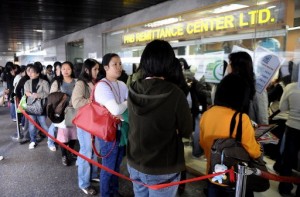
Filipino domestic helpers line up to send money at a remittance center in the central district of Hong Kong in this 2008 file photo. Given expectations that remittances would continue to increase this year and that export earnings would rebound moderately from last year’s contraction, the central bank projects that the GIR would hit at least $79 billion by the end of the year. AFP PHOTO/TED ALJIBE
Remittances from overseas-based Filipinos reached $1.7 billion in April, up 5.3 percent from $1.62 billion in the same month last year.
This brought the inflows for January to April to $6.5 billion, which was 5.4-percent higher than the $6.2 billion sent in the same period of 2011.
The Bangko Sentral ng Pilipinas said in a statement that the four-month transfers rose on the back of higher remittances from both sea-based and land-based workers. Remittances from the former grew 14.6 percent to $1.5 billion while those from the latter rose 2.8 percent to $5 billion.
In terms of territories from where the funds were sent through banks, the top 10 sources were the United States, Canada, Saudi Arabia, Japan, the United Kingdom, the United Arab Emirates, Singapore, Italy, Germany, and Hong Kong.
The BSP said inflows were sustained due to the steady demand for Filipino workers abroad as well as the expanded access of overseas Filipinos and their beneficiaries “to a diverse and innovative range of financial products and services offered by banks and other financial institutions.”
Citing preliminary data obtained from the Philippine Overseas Employment Administration, the BSP said workers classified as new hires with processed contracts and were awaiting deployment rose 16.5 percent to 85,009 for the period January-February 2012 from 72,941 in the same months last year.
For January to May, approved job orders totaled 334,945, of which about a third or 100,848 consisted of processed job orders for service, professional, technical, and production and related workers. These workers were intended for deployment to Saudi Arabia, the UAE, Qatar, Kuwait, Taiwan, Singapore and Hong Kong.
“Increased inflows of overseas Filipinos’ cash remittances were also made possible by the continued expansion of banks’ presence across the globe through tie-ups established by local financial institutions with foreign and local money transfer operators, mobile phone service operators and pawnshops,” the BSP said.
The BSP yesterday started computing remittance inflows in line with the International Monetary Fund’s Balance of Payments and International Investment Position Manual, 6th edition (BPM6).
BMP6 provides the framework for the compilation of the balance of payments and provides guidance on the recording of cross-border transactions and positions according to a set of internationally agreed guidelines.